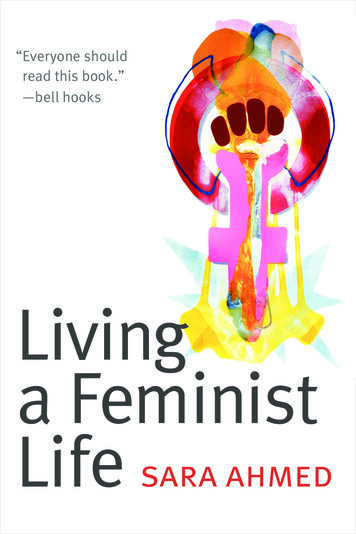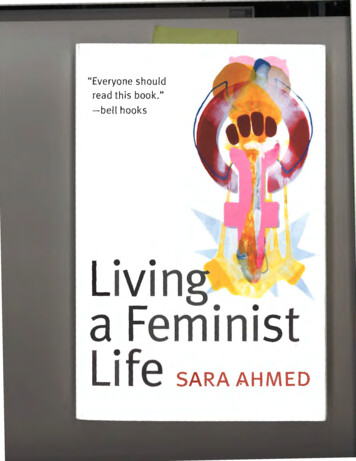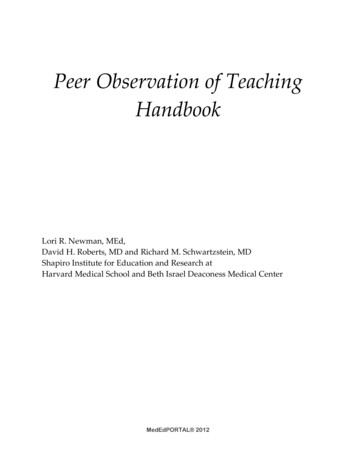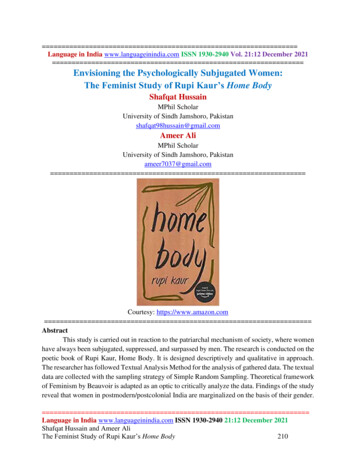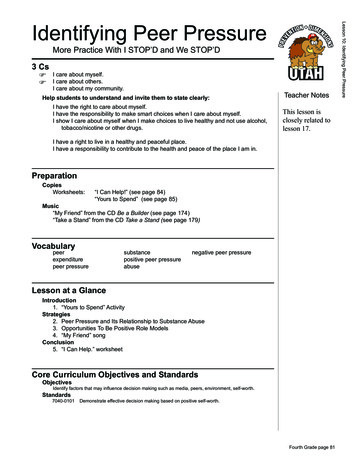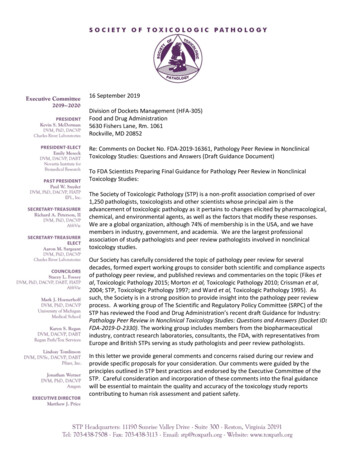
Transcription
Peer ReviewedTitle:A Radical Theory of Bodies: Synthesizing the Manipulation of Corporeal and Affective Bodies inFeminist TheoryJournal Issue:Global Societies Journal, 3Author:Baker, Sally, UC Santa BarbaraPublication /3m41z83sKeywords:Gender Performativity, Corporeality, Affectivity, Bodies, Cultural MediationLocal Identifier:gis globalsocieties 29255Abstract:Drawing chiefly upon Judith Butler’s theory of gender performativity, this article argues that feministtheory does not operate in isolation from the body, but rather that the body is a medium throughwhich feminist theory is performed. It examines how various feminist theorists conceive of thebody, both corporeally and affectively, and how the body is mediated by a variety of culturallyspecific forces. Through a carefully crafted Butlerian lens, the article examines the body of the thirdworld prostitute, the body of the fetus, the invasion of bodies by modern capitalism, the reimaginingof the body in radical feminist utopia, and other constructions of the body. By placing the work ofmultiple feminist theorists in conversation with one another, the article offers theoretical insight bysynthesizing seemingly disparate feminist theories.Copyright Information:All rights reserved unless otherwise indicated. Contact the author or original publisher for anynecessary permissions. eScholarship is not the copyright owner for deposited works. Learn moreat http://www.escholarship.org/help copyright.html#reuseeScholarship provides open access, scholarly publishingservices to the University of California and delivers a dynamicresearch platform to scholars worldwide.
49 Global Societies Journal, Volume 3, 2015A Radical Theory of Bodies:Synthesizing the Manipulationof Corporeal and AffectiveBodies in Feminist TheoryBy: Sally Baker, UC Santa BarbaraABSTRACTDrawing chiefly upon Judith Butler’s theory of gender performativity, this articleargues that feminist theory does not operate in isolation from the body, but rather thatthe body is a stage for the performance of feminist theory. It examines how variousfeminist theories conceive of the body, both corporeally and affectively, and how thebody is mediated by a variety of culturally specific forces. Through a carefully craftedButlerian lens, the article examines the body of the third world prostitute, the body ofthe fetus, the invasion of bodies by modern capitalism, the reimagining of the body inradical feminist utopia, and other constructions of the body. By placing the work ofmultiple feminist theorists in conversation with one another, the article offerstheoretical insight by synthesizing seemingly disparate feminist theories.Keywords: Gender Performativity; Corporeality; Affectivity; Bodies; Cultural MediationINTRODUCTION: INTERPRETATIONS OF THE BODYWhile exploring deeply theoretical questions, the work of many feminist theorists isrooted in the corporeal, or physical, body. In theoretical terms, the body represents far morethan its mere physicality. For Judith Butler, leading feminist theorist at UC Berkeley, thebody becomes legible through a series of performative acts that interpellate gender in tobeing.1 For Betty Friedan, prominent second-wave feminist and writer, the physical locationof the body has psychological ramifications, and the politics of female liberation are rooted inthe literal movement of the body out of the domestic space of the home.2 Both Butler andFriedan conceive of the body as a mobile unit, whether in theoretical terms (for Butler), orthrough physical movement (for Friedan). By rooting my analysis in the framework of Judith1Butler, Judith. "Performative Acts and Gender Constitution: An Essay in Phenomenology and FeministTheory." In Feminist Theory Reader, edited by Carole R. McCann and Seung-Kyung Kim (New York City:Routledge, 2013), 462-73.2 Friedan, Betty. The Feminine Mystique (New York City: WW Norton & Company, 1963).
A Radical Theory of Bodies 50Butler’s theory of gender performativity, I will explore how prominent feminist theorists, likeFriedan, manipulate the body, both corporeally and affectively. Through my analysis, Ichallenge the notion that feminist theory is devoid of practical application by arguing that itdoes not operate in isolation from the body, but rather that the body is the chief actor in theperformance of feminist theory. Thus, the body is the nexus of performativity, and the sitethrough which theoretical and practical applications are expressed. Positioning the body asthe site of union for theory and practice establishes it as a potentially radical entity.FORMATION OF THE GENDERED BODYIn her essay, “Performative Acts and Gender Constitution: An Essay inPhenomenology and Feminist Theory,” Judith Butler argues that “gender is in no way astable identity or locus of agency from which various acts proceed; rather, it is an identitytenuously constituted in time – an identity instituted through a stylized repetition of acts.”3For Butler, gender is performed and created through literal manipulations of the physicalbody. Gender does not presuppose succeeding acts or experiences, but is rather createdthrough the acts or experiences. As a form of identity, gender as a theoretical concept ismalleable and, in fact, dependent upon outside forces. Butler argues that gender is not a“locus of agency,” suggesting that other acts do not proceed forth from it. Rather, gender isformed in ways similar to other forms of identity: through the tenuous nature of ordinaryexperiences and actions. If gender, as an unstable identity, is strongly rooted in bodily acts,then the body, for Butler, is also an unstable entity. Were the body to exist in a static space,devoid of cultural contingencies and outside forces acting upon it, gender would be a fixedidentity. Since Butler positions the physical and theoretical body as moving through time andspace, it is constantly evolving in relation to external identities, subjectivities, and stimuli.Since Butler argues that gender is formed through its relation to the manipulation ofthe body, both gender performativity and the body itself are amorphous. Butler posits that,“One is not simply a body, but, in some very key sense, one does one’s body and, indeed, onedoes one’s body differently from one’s contemporaries and from one’s embodiedpredecessors and successors as well.”4 The body is thus the facilitator of action andembodiment, as the process of embodiment is felt through the performative, stylized acts ofthe body. Butler argues that the body does not merely exist, but is performed. Through therepetition of stylized acts, the body comes into being through both unconscious andconscious actions. Consequently, the tension in “doing one’s body,” as Butler describes it,involves both the conscious and the unconscious. Doing one’s body “differently from one’scontemporaries and from one’s embodied predecessors and successors” situates theperformativity of individual bodies as individualistic and contingent upon a specificcombination of influences. Thus, Butler’s theory of gender performativity suggests that notwo physical or theoretical bodies are the same, as performance is varied and3Butler, Judith. "Performative Acts and Gender Constitution: An Essay in Phenomenology and FeministTheory." In Feminist Theory Reader, edited by Carole R. McCann and Seung-Kyung Kim, 462. New York City:Routledge, 2013.4 Ibid., 464. Emphasis added.
51 Global Societies Journal, Volume 3, 2015multidimensional. Through this framework of one not simply being “a body,” but rather“doing” one’s body, I will shape the rest of my analysis.LAYERED SUBJECTIVITES AND COMMODIFICATION OFIDENTITYProfessor of English at Rice University, Rosemary Hennessy’s essay, “The Value of aSecond Skin,” begins with the assertion that, “The human person is never merely anindividual, but lives always in social relation.”5 Perhaps in a nod to French philosopher LouisAlthusser, Hennessy does not position the human person as an individual with an innatecapacity for free will, but as a subject interpellated by culturally specific significations (SeeLouis Althusser, “Ideology and Ideological State Apparatuses”). Althusser argues that one’ssubjectivity is formed through one’s interpellation into being by ideology. He offers theexample of a policeman exclaiming, “Hey, you there!” in public and someone turningaround. The moment the person responds to the call by turning around, the person recognizeshimself as a subject. In analyzing Hennessy alongside Althusser’s theory of interpellation, itis through her positioning of the human person as always living in “social relation” to otherforces that she constructs her theory of the second skin. Hennessy frames much of heranalysis in the context of workers, and mentions the aggressive invasion of bodies by moderncapitalism.6 In her conception of the “invasion” of bodies, Hennessy argues in favor of theclaim that bodies do not exist autonomously, but in relation to other material and emotionalforces. As a producer of capital, Hennessy claims that the body and its many identities arecommodified in a capitalist society obsessed with economic profit and social advancement.In relation to the central theme of the body, Hennessy’s theory of the second skin canbe read as a layer of the body. Or, like layers of clothing. Through her reading of the secondskin, Hennessy argues that it is to “place the lives and contested cultural values of identity inrelation to the surplus value capital relies upon.”7 In this sense, Hennessy conceives of thebody as generative, and the second skin relates human value to productive value. In theparticular context of capital, the second skin is manipulated to produce surplus value. Thebody, as a tool of agency, generates capital through its abilities and capabilities, therebycontinually adding value through modes of productivity. Hennessy’s discussion of a “secondskin” locates the body as an entity layered with productive capabilities. Each skin, as apotentially productive identity, adds to the theoretical base of the single-layered body, or thebody interpreted apart from the added skins. In a capitalist context, the addition of skins, oridentities, increases the productive value of the body. Through reading “worker” as a secondskin, one’s worker body and identity as worker are joined. Hennessy thus complicates therelationship between felt identities and the body as a labored subject.5Hennessy, Rosemary. "The Value of a Second Skin." Intersections between Feminist and Queer Theory, 2006,116.6 Ibid., 120.7 Ibid., 120.
A Radical Theory of Bodies 52While Hennessy does account for the body as a performative subject, she supports JayProsser’s critique of Judith Butler’s theory.8 Prosser, a social theorist at the University ofLeeds, argues that in the articulation of social constructivism as the leading thesis in feministtheory, the “relation between the psyche and body in shaping gender identity” is lost. 9 Thetheory of social constructivism, as opposed to biological determinism, states that gender is asocial construct, shaped and molded by cultural, social, and political forces. It directlyopposes the theory of biological determinism, which argues that gender and sexuality aredetermined by innate, biological principles. Hennessy’s discussion of the second skin assomething that is put on in the service of the body seeks to intervene in this narrative, andconnect the psyche of the body to its physicality. In her discussion of the abject, Hennessyrestates Butler’s argument that the act of abjecting something that is “not” the self “sets upthe boundaries of the body, which are the first contours of the subject.”10 The concept of“abject,” as coined by Bulgarian-French philosopher Julia Kristeva in The Powers of Horror,articulates the human response to the potential breakdown of distinction between “self” and“other.”11Through the theory of abjection, Hennessy shapes the subject both in relation to thevalue the second skin imparts, or what the subject is, as well as through what the subject isnot. If the second skin is the identity that the worker exchanges for a wage, then the bodyitself becomes currency in the capitalist system. In the literal manipulation of bodies,Hennessy positions the second skin as a film that wraps around the body. The body is thusable to take on various forms through the addition and removal of multiple skins.INJURED IDENTITY AND THE THIRD WORLD PROSTITUTE BODYIn her essay, “Ouch! Western Feminists’ ‘Wounded Attachment’ to the ‘Third WorldProstitute,’” social critic Jo Doezema draws upon Wendy Brown’s theory of “injuredidentity” in order to examine the politics of anti-trafficking campaigns.12 Doezema argues,“the ‘injured body’ of the ‘third world trafficking victim’ in international feminist debatesaround trafficking in women serves as a powerful metaphor for advancing certain feministinterests, which cannot be assumed to be those of third world sex workers themselves.”13 Thespecific “injured body” of the third world prostitute implicates both identity and physicalityas injury. The white western feminist codes the third world prostitute body as a site ofpatriarchal oppression and violence that is in need of saving. Through establishing ahierarchy of oppression, the rhetoric of “saving” removes all agency from the body of thethird world sex worker. Thus, in appropriating an injured identity upon a subject ofIbid., 120 - “Prosser reads social constructivism as an important critique of the positivist notion that biologydetermines gender. But along with other transsexual critics, he emphasizes that the unfortunate effect has beento replace the scientific concept of gender as the expression of a natural core identity with a new understandingof gender as a purely discursive reiterative practice.”9 Ibid., 120.10 Ibid., 121.11 Kristeva, Julia. Powers of Horror: An Essay on Abjection. Trans. Leon S. Roudiez. New York: Columbia UP,1982.12 Doezema, Jo. "Ouch! Western Feminists' 'Wounded Attachment' to the 'Third World Prostitute,'" FeministReview 67 (Spring 2001), 16.13 Ibid., 17.8
53 Global Societies Journal, Volume 3, 2015“otherness,” the body of the “other” is controlled by the one abjecting. By abjecting the thirdworld prostitute body as “not self,” white western feminists reify their own bodies.Doezema positions these respective bodies within a hierarchical structure: “‘saving bodies’were middle class and white; the ‘suffering bodies’ working class or black and colonial.”14For Doezema, the body is not a blank entity upon which forces act; rather, it is a site shapedboth by internal and external forces. As race marks some bodies while leaving othersunmarked, Doezema explores how bodies are implicated in notions of “salvation.” Throughthe literal placement of white and brown bodies, Doezema draws attention to the ways inwhich the bodies are politicized in entirely different ways, according to the narrativesattached to them. The third world prostitute body is not only viewed as a corporeal injury, butalso as an affective injury. Through the process of othering based on difference in physical,visible bodies (corporeal) and othering based on ideological difference (affective), the injuryof the third world prostitute body functions in two senses. Injury is constructed in directrelation to difference, and according to variance in physicality and ideology between thetenets of white western feminism and the perceived experience of the third world prostitute.In relation to Butler, white western feminists appropriate the performance of injury on to thethird world prostitute body. While the third world woman is not actively performing injury,the interpretation of her body as injured renders her an injured subject.PROCESSES OF “BECOMING” A GENDERED BODYButler critiques the concept of “becoming” a woman that French writer andintellectual, Simone de Beauvoir, espouses in The Second Sex, where the body is integral toprocesses of embodiment.15 While Butler may perhaps position performative acts as anapproximation to embodiment, de Beauvoir actively associates the embodiment ofwomanhood directly with the physical body. Butler positions the body as embodied throughthe performance of gender. Since she argues that the process of gender performance is alwaysevolving, the body can only ever approach embodiment, rather than attain it. De Beauvoirargues that woman “finds herself living in a world where men compel her to assume thestatus of the Other,” almost as if man abjects woman in order to control her.16 If men compelwomen to the status of “other,” as de Beauvoir argues, then the process of embodiment, andwoman’s relation to her body, involves challenging the position of “other” through a processof re-embodiment. For de Beauvoir, as woman moves towards embodiment, she must shapewhat it means to be a woman. She also argues that society positions woman as what is “notman.”17 Thus, woman’s body is positioned in relation to man’s body, for woman is thedisembodied foil to man’s embodiment.In relation to de Beauvoir’s argument that bodies act in relation to one another, Butlerargues: “For Beauvoir, the body is understood to be an active process of embodying certain14Ibid., 22.Butler, 462.16 Simone de Beauvoir, "Introduction to The Second Sex." In Feminist Theory Reader, ed. Carole R. McCannand Seung-Kyung Kim, (New York City: Routledge, 2013), 43.17 Ibid., 41.15
A Radical Theory of Bodies 54cultural and historical possibilities.”18 Butler expands this concept of embodiment to includegendered acts, acts that both constitute meaning, or cultural legibility, and through whichmeaning is constituted. “Meaning,” in relation to surrounding social structures, refers to theproduction of significance within a specific sociopolitical locale. Butler further argues that deBeauvoir does not deny the existence of the “natural dimensions of the body,” but positionsthe body as distinctly separate from the process through which it develops cultural meaning. 19While de Beauvoir is interested in the process of how one comes to embody a body, Butler isinterested in how manipulation of bodily acts reconfigures the formation of gender itself.SEXUAL MEDIATION OF THE BODYWhile Butler’s concern is with the process by which gender is created and sustainedthrough the body, sex and gender theorist Gayle Rubin engages with the gendering of bodieson a deeply physical plane. In “Thinking Sex,” Rubin calls for a radical theory of sex, whichshe states, “must identify, describe, explain, and denounce erotic injustice and sexualoppression.”20 Rubin explicitly links the felt experiences of bodies to the acts that bodiesengage in, connecting the psyche to the body. For Rubin, the erotic realm must not be thoughtof as separate from the body, for it is lived out through the body. One of Rubin’s keyarguments is that, “We never encounter the body unmediated by the meanings that culturesgive to it.”21 Rubin argues: “The body, the brain, the genitalia, and the capacity for languageare all necessary for human sexuality. But they do not determine its content, its experiences,or its institutional forms.”22 In accordance with Butler’s theory of performativity, and theprocessual nature of embodiment, Rubin articulates the body, brain, genitalia, and capacityfor language all as necessary components of sexuality, but does not assert that any of theentities precede sexuality. Rather, human sexuality, like gender, is in a constant state ofcreation based on the specific combination of the body, brain, genitalia, and capacity forlanguage at any given time.Rubin distinguishes between the body as a physical site and the body as an imaginedsite through which cultural meaning is explored and expressed. If bodies are always alreadymediated for Rubin, then this directly challenges Butler’s theory of bodies as in the processof performing gender. If the body is already mediated by cultural meaning as Rubin suggests,then the process of gendered embodiment is far more complex than Butler accounts for. Thebody as a mediated entity cannot simply call gender into existence through the repetition ofstylized, performative acts; rather, these acts are already inherently mediated and interpreted.In her theorization of the “charmed circle” of sexual activity, Rubin places thecorporeal body in the center. In the movement from “good, normal, natural, blessedsexuality” to “bad, abnormal, unnatural, damned sexuality,” the physical body moves through18Butler, 463.Ibid.20 Rubin, Gayle S. "Thinking Sex," in Pleasure and Danger: Exploring Female Sexuality, ed. Carole S. Vance(Boston: Routledge, 1984) 921 Ibid., 10.22 Ibid., 10.19
55 Global Societies Journal, Volume 3, 2015spaces that have already been interpreted by society.23 As the charmed circle is constructedbased on how bodies act upon one another, there is a clear correlation between bodies, sex,and sexuality. If sexual activity requires a body, then sexual activity predates sexuality in thecharmed circle. This assertion relies on the assumption that sexuality and sexual activity areinterdependent. A Butlerian reading of the charmed circle would perhaps suggest that theidentity category of sexuality and the enactment of various sex acts aids one in theperformance of gender, or even that gender performance depends upon the enactment ofsexuality, in some sense. Through her representation of perceived notions of sexuality, Rubinsituates the conversation about sexuality in direct contact with the body. According to thelogic that Rubin sets forth in her discussion of the charmed circle, society perceives sexualityas being formed through the body. Rubin goes on to advocate for sex positivity within aradical theoretical context, but it is her particular focus on physical bodies that allows for theconstruction of an imaginative, sex radical theorization.REPRODUCTION AND IMAGINED BODIESA body often found at the center of theoretical feminist debates is the body of themother. While Betty Friedan discusses motherhood in the context of domesticity, EmmaGoldman, a prominent developer of anarchist political theory in the early 20th century,addresses the ability to control pregnancy as an integral part of motherhood. In her article“The Social Aspects of Birth Control,” Goldman argues that, “Surely, [the mother] ought tobe in a position to decide how many children she should bring into the world, whether theyshould be brought into the world by the man she loves and because she wants the child, orshould be born in hatred and loathing.”24 While Goldman is primarily focused on the body ofthe mother, she also focuses on the ability of the maternal body to give birth to more bodies.A mother has the potential to produce more bodies, which places the great burden of“biological vulnerability,” as Goldman terms it, upon her. Biological vulnerability is a stateof being in which the maternal body is haunted by the prospect of reproduction.Goldman also implicates male bodies in her discussion by stating: “It is not woman alonewho is beginning to realize the importance of Birth Control. Men, too, especially workingmen, have learned to see in large families a millstone about their necks ”25 There is aconcern in Goldman’s support for reproductive rights not only for women, but also for men.In the acknowledgement of budding male support for the movement, Goldman appeals to thepotential for bodily leisure. The implication is that birth control will also relieve men of theirdoubly exhaustive duties as provider and father. Thus, Goldman also manipulates bodilyidentities through her manipulation of the corporeal body.23Ibid., 13.Emma Goldman, "The Social Aspects of Birth Control," Mother Earth 11 (April 1916), 469.25 Ibid., 469.24
A Radical Theory of Bodies 56CONSTRUCTIONS OF THE MOTHER BODY AND THE “NON-BODY”While also exploring the “mother” body, American journalist and feminist EllenWillis further complicates Goldman’s notions of motherhood in her piece, “Putting WomenBack into the Abortion Debate.”26 Willis argues that abortion is a feminist issue above all,and that the question of the fetus is always asked without regard for the woman’s body.27Through the construction of the fetus as a “non-body,” Willis inserts the body of the womanback into the abortion debate. She states, “I believe the debate has to start in a different place– with the recognition that fertilized eggs develop into infants inside the bodies of women.”28Willis draws attention to the “body” within the body, but highlights the importance of notoverlooking the outward body in the quest to validate the life of the forming inward body.Rather than situating “Are fetuses the moral equivalent of human beings?” as the keyquestion in the abortion debate, Willis argues that the real central question should be, “Can itbe moral, under any circumstances, to make a woman bear a child against her will?”29 In herrepositioning of bodies, Willis reads the woman’s body apart from the fetus. While stillmediated, as Rubin would argue, the woman’s body does not have to become gendered as“mother” through the iterative, generative “performance” of childbearing.THE AMERICAN SUBURBAN HOUSEWIFE BODYWhile Emma Goldman is primarily concerned with advocating for a means to protectthe female body from becoming unwillingly maternal, Betty Friedan is concerned with the1960s American suburban housewife body in The Feminine Mystique. For Friedan, the“problem that has no name” is far more arresting than the implications of the suburbanhousewife’s sociopolitical position.30 Rather than complicating the idea that a movement outof the house would solve every depressed, forlorn feeling a housewife may have, Friedanpositions the body of the housewife as a captive in the home. She asks, “Can the problem thathas no name somehow be related to the domestic routine of the housewife? When a womantries to put the problem into words, she often describes the daily life she leads.”31 In herexposure of this “problem that has no name,” Friedan theorizes that it is likely affiliated withthe literal daily movements of the housewife body. As she moves through the houseperforming mundane tasks, the tasks come to define her. Friedan argues that the suburbanhousewife comes to have no identity outside the home, and hardly an autonomous identityinside the home either. Read alongside Butler, the iterative performance of “housewife care”creates the gendered identity of “housewife.” Friedan focuses on housewifery as a sort ofperformance, yet does not seek to complicate the implications of moving a body outside ofWillis, Ellen. “Putting Women Back intoCountercultural Essays. Wesleyan U Press, 1992.26the Abortion Debate.” No More Nice Girls:(28Ibid., 515.Ibid., 516.30 Friedan, Betty. The Feminine Mystique (New York: W.W. Norton & Company, Inc. 1963). 1.31 Ibid., 18.29
57 Global Societies Journal, Volume 3, 2015the home. Rather than a shift in understanding in the process of identity construction, Friedanargues for a shift in bodies outside of the domestic sphere.BODILY MOBILITY IN FEMINIST UPTOPIAIf all of the above mentioned feminist theorists are concerned with the movement andmanipulation of bodies, radical American feminist Valerie Solanas’s SCUM Manifestopresents a profound alternative imagining for the potential of bodies.32 While the othertheorists have implicitly or explicitly made allowance for the assumed male body, Solanaspositions the female body as the only necessary body in a utopic, post-male world. Solanascollapses the male body into the female body, while still preserving the separateness of thefemale body. In her treatise on sex, Solanas states: “Screwing, then, is a desperate,compulsive attempt to prove he’s not passive, not a woman; but he [man] is passive and doeswant to be a woman.”33 In her radical reimagining of gendered and sexed bodies, Solanassuggests that there is really only one necessary body: female. If the female body is the onlynecessary body, then, it follows that all males must want to be females. In her drasticreimagining of a world in which men are rendered obsolete, Solanas does what feministtheorists only hint at: imagine a world in which bodies are unmediated. The mediated malebody is eliminated, to leave only the “perfect female” body. If this is the body that survives,perhaps it can be read as unmediated. If, according to Solanas, patriarchy is constantlymediating female bodies, then a removal of patriarchal forces creates a potentiallyunmediated subject. Within the specific context of feminist utopia, the resilience of thefemale body shapes a world order in which patriarchal forces are dismantled, rather thanreconstructed.CONCLUSION: A RADICAL THEORY OF BODIESJudith Butler’s theory of gender performativity positions the body as the site throughwhich the repetition of theatrical, stylized acts are performed. When read alongside Butler’stheory, the work of other feminist theorists, such as Jo Doezema and Gayle Rubin, thinks ofthe body in expansively theoretical, rather than physically linear, terms. If Rubin argues for anew radical theory of sex, I would argue for a new radical theory of bodies. In expanding thebody beyond the corporeal body, bodies can be interpreted by identity politics. If the psycheand the body are to be kept in conversation, as Hennessy argues, then the corporeal andaffective bodies must work alongside one another, as an analysis in varied theories proves.Reimagining bodies in an innovatively radical way makes space for alternative communitiesof bodies, as expressed in Solanas’s manifesto. Feminist utopian literature should not be theonly place where progressive articulations of the body are represented; instead, the joining ofcomplex understandings of corporeal and affective bodies in feminist theory has the potentialto reimagine gender and sex in radical wa
A Radical Theory of Bodies 52 While Hennessy does account for the body as a performative subject, she supports Jay Prosser’s critique of Judith Butler’s theory.8 Prosser, a social theorist at the University of Leeds, argues that in the articulation o
